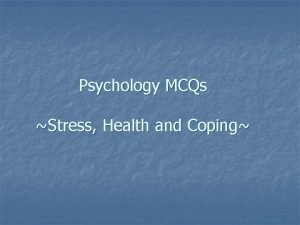Expressed Emotion stress coping cortisol and the child

- Slides: 1

“Expressed Emotion”, stress coping, cortisol and the child: an experiment Hanna Christiansen 1, Bernd Röhrle 2, Berthold Hauffa 3, Robert D. Oades 1 1 Clinic for Child and Adolescent Psychiatry University of Duisburg-Essen, 2 Philipps-University Marburg – Department of Clinical Psychology, 3 Pediatric Nephrology University of Duisburg-Essen Results Attention Deficit / Hyperactivity Disorder (ADHD) is one of the most common psychiatric disorders in childhood. Maternal warmth, a component of Expressed Emotion (EE), has been shown to be reduced in parents of children with ADHD, whereas hostility / criticism (another component of EE) towards the child dominates the parent-child relationship (Tully et al. , 2004; Schimmelmann et al. , 2003; Daley et al. , 2003). The consequences for the child of this impaired relationship, especially the physiological responses, have not yet been studied, although a few studies have shown reduced hypothalamo-pituitary-adrenal axis (HPA) activity in children with ADHD (Kaneko et al. , 1993, King et al. , 1998). Our aim here was to record behavioural and physiological responses in children and parents challenged by different conditions of EE. Discussion We replicated the common finding of high hostility and low warmth in parents of ADHD children. This interrelation results in higher physiological stress levels of the ADHD child, when manipulated experimentally. We did not find any differences in baseline cortisol between ADHDs and controls, and can thus assume that the HPA-axis is not generally impaired in ADHDs. In two studies Adam (Adam et al. , 2006, Adam, 2006) showed that negative emotions (e. g. loneliness, sadness) were associated with higher cortisol responses. In contrast to the situation with the controls, the ADHD parent-child-relationship in this study, seems to lack the factors that normally buffer negative emotions expressed by parents towards the child. References Adam (2006) Psychoneuroendocrinology 31: 664 -679. Adam et al. (2006) PNAS 103: 17058 -63. Daley et al. (2003) Br J Clin Psychol 42: 53 -67. Kaneko et al. (1993) J Autism Dev Disord. 23: 59 -65. King et al. (1998) Biol Psychiatry 44: 72 -4. Schimmelmann et al. (2003) Fortschr Neurol Psychiatr. 71: 517 -526. Tully et al. (2004) J Consulting Clin Psychol 72: 218 -226. X =. 326 SD =. 15 Cortisol in ng/d. L X =. 176 SD =. 09 HEE critcal HEE EOI critcal & EOI ADHDs X =. 205 SD =. 11 Parents of ADHDs Controls ANOVA Children F = 2. 229, p =. 138 Low EE X =. 320 SD =. 17 ANOVA Parents F =. 04, p =. 842 Figure 2: Baseline Cortisol Figure 1: EE Rating, p. 000, . 190 ▄ ▄ ADHD x pap ▄ ADHD x neutral ▄ ADHD x alone Controls x pap ▄ Controls x neutral ▄ Controls x alone Cortisol in ng/d. L Figure 3 & 4: Cortisol distribution children; main effect p. 000, . 343; interaction p. 004, . 130 Parents of ▄ ▄ ADHDs x pap Controls x pap ▄ ADHDs x nap ▄ Controls x nap ▄ ADHDs x neutral ▄ Controls x neutral ▄ ADHDs x alone ▄ Controls x alone Cortisol in ng/d. L Participants included one group of 60 ADHD children and their parents and another group of 60 healthy control children and their parents. EE was assessed with the Five Minute Speech Sample (FMSS). After baseline measures of cortisol in parents and children, all participants were divided into 4 subgroups according to an attitude priming condition (positive [PAP], negative [NAP], neutral, child alone). After priming, the children performed a stop-signal task during and after which 4 further measures of salivary cortisol were taken over a 1 hour period. Ratings of the children’s response (Perceived Criticism scale, PC) were made before attitude priming (PAP / NAP) and after the final cortisol measure. of ADHDs ▄ Parents of Controls Cortisol in ng/d. L Study sample & Method ▄ Parents Cortisol in ng/d. L University of Duisburg-Essen, Child and Adolescents Psychiatry Introduction Figure 5 & 6: Cortisol distribution parents; main effect p. 000, . 614; interaction p. 837, . 049 Pearson Correlations ADHD children Condition (pap / neutral / alone) FMSS Hostility Control children Perceived Criticism T 1. 309 n. s. Condition (pap / neutral / alone) FMSS Hostility Perceived Criticism T 2 -. 111 n. s. . 226*. 360* Figure: 7 Results - Expressed Emotion & Cortisol Parents of ADHD and control children differ significantly in all FMSS measures, especially in warmth and hostility (Fig. 1). This is related to the expression of ADHD symptoms. There are no differences in baseline cortisol levels between the two groups of children or the groups of parents (Fig. 2). Control children and the parents of both groups also show the expected circadian decrease in cortisol over successive measures (Fig. 4, 5, 6). ADHDs only show the expected decrease in the positive and neutral condition, but cortisol levels remain high and do not decrease in the negative condition or when studied alone (Fig. 3). ADHD children do not explicitly perceive the criticism expressed by their parents (attitude priming), whereas control children do (Fig. 7), - but ADHD children do react to criticism at a physiological level (cortisol levels do not decrease). Acknowledgement: This work was partly funded by NIMH Grant RO 1 MH 062873 to S. Faraone

